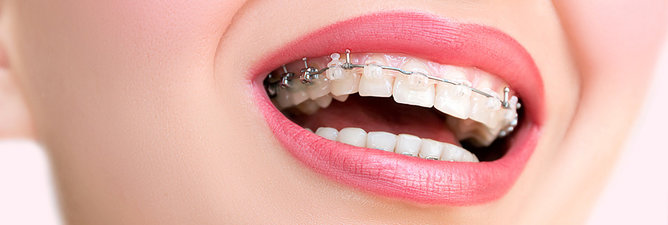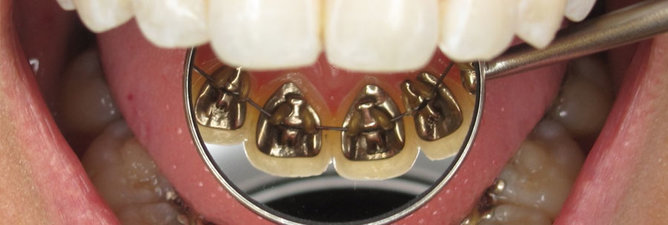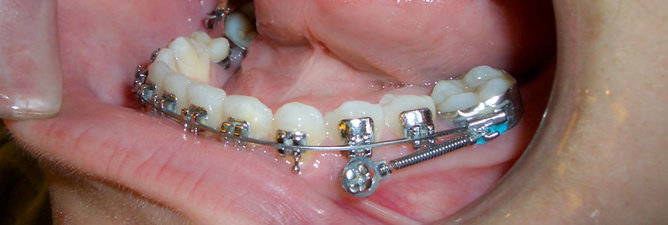-

 Treatments
Treatments
Treatments

Age 7 is the optimal time to bring your child for their first orthodontic consultation, according to the American Association of Orthodontists. This is because your child’s jaw has developed enough to have some adult teeth present, and to show how further growth and development will continue.

Frequently started between the ages of 12 and 16, since most permanent teeth will be in place, the teen years are the most common time for orthodontic treatment. Experienced orthodontists like Dr. Pham will also be able to easily detect issues with spacing, crowding, bite, and alignment in this age range, and the bone and jaw structure are formed enough to allow orthodontic treatment to begin.
Between the ages of 11 and 15 is the most common time for orthodontic treatment, and for good reasons. By age 12, most if not all of the permanent teeth have erupted and are in place, and crooked teeth, gaps and bad bites can easily be detected. These problems will hardly ever correct themselves, so this is when most parents decide to seek orthodontic treatment.
Besides the benefits of fitting in with their friends, children at this age are growing rapidly, and we can usually take advantage of these growth spurts to help shape the bite and teeth correctly. And children at this age have high metabolisms, which can help shorten overall treatment time and reduce the discomfort of orthodontic treatment.

Braces aren’t just for kids anymore. Tooth alignment can be changed at any age if your gums and bone structure are healthy.
Orthodontic treatment at later stages in life can dramatically improve your personal appearance and self confidence. Improving the health of your teeth and gums is equally important. Crooked teeth and a bad bite can contribute to gum and bone loss, tooth decay, abnormal wear of the tooth enamel and surfaces.
Good news! The new techniques and appliances we use greatly reduce discomfort levels, decrease the frequency of visits, shorten treatment time and may allow you to choose from several options. Even if you were previously told you are not a candidate for braces or Invisalign, technology has advanced and you may be able to get the smile you have always dreamed of without the need for surgery.

Metal braces are the traditional option if you want your smile straightened, and they continue to be one of the most popular options for children.
Made of high-grade stainless steel, these braces straighten your teeth with metal brackets and archwires, and they are more comfortable today than they have ever been in the past.
Metal braces tend to be the least expensive option. They are also the fastest treatment option. The stainless steel is very strong, and that makes it easy for the orthodontist to adjust the braces in a way that effectively moves your child’s teeth.
In addition, metal braces are permanently in your child’s mouth until the orthodontist removes them. That makes them impossible to lose. With retainers, you often end up buying replacements or digging through garbage cans after your child has lost them.

Ceramic braces are the same size and shape as metal braces, except that they have tooth-colored or clear brackets that blend in to teeth.
Clear braces are a cosmetic alternative to metal braces that blend in better with your teeth and are less noticeable. They are a great option for those who want braces but don’t want them to show and also for those who are not candidates for Invisalign but still desire a less visible solution.
Ceramic braces are a less noticeable type of braces used for straightening teeth in adults and teens who are concerned about the cosmetic appearance of their braces. These braces are secured to your teeth and are tightened at regular intervals by the orthodontist just like traditional metal braces.
You may experience some soreness after each tightening session. This is a normal result of your teeth being shifted into alignment. The length of the intervals will be determined during an initial appointment with our orthodontist.

Invisalign clear aligners are a virtually invisible solution, so you can smile confidently both during treatment and after.
Using a series of clear, removable aligners, Invisalign treatment gradually moves your teeth toward the smile you’ve always wanted. And, almost no one will know your wearing them unless you tell them.
Because the aligners are removable, you can continue to eat your favorite foods and you can brush and floss normally to keep your teeth and gums healthy.
Invisalign can treat many common conditions like crowding, spacing, overbite, underbite, deep bite and open bites. The results are comparable to the results with more traditional appliances but they are much more suited to compliment your lifestyle.
With over 20 years of clinical research, more than 700 patents, and more than 4 million cases started, you can be confident that your smile is in good hands with Invisalign.

Lingual braces are placed behind the teeth and therefore offer a great alternative for those who want their teeth straightened, without the braces showing.
The process for lingual braces involves taking an impression of the teeth, which is then sent to a dental laboratory and used to create customized brackets. The process takes about six weeks and, once complete, allows the orthodontist to use a specific process to cement the braces onto the back surfaces of your teeth.
Like traditional braces, this product works by applying gentle yet continuous pressure on the teeth, to help them slowly shift into proper position. The treatment can take anywhere from 18-36 months, depending on the severity of a patient's overcrowding of teeth or their bite.

Also called “Orthodontic Mini Implants or “OMI”, these appliances are ultra small mini screws that are judiciously placed in the bone to help affect desired tooth movement.
Usage
TADs are used to augment anchorage when the desired tooth movement is in need of a “power boost”. These appliances are hooked to braces on the teeth to aid in space closure, midline correction, bite closure, and many other functions. TADs are often used to supplement or substitute for elastics.
What to Expect
Placement of the TADs is performed by the orthodontist, oral surgeon, periodontist or general dentist. The actual placement often does not require anything more than anesthetic gel on the gums! A patient may experience an adjustment period much like with braces placement. Removal of the TAD only requires anesthetic gel and healing of the gum tissues requires only a few days at most.
- Children
- Teens
- Adults
- Traditional Braces
- Ceramic Braces
- Invisalign®
- TADs

Age 7 is the optimal time to bring your child for their first orthodontic consultation, according to the American Association of Orthodontists. This is because your child’s jaw has developed enough to have some adult teeth present, and to show how further growth and development will continue.

Frequently started between the ages of 12 and 16, since most permanent teeth will be in place, the teen years are the most common time for orthodontic treatment. Experienced orthodontists like Dr. Pham will also be able to easily detect issues with spacing, crowding, bite, and alignment in this age range, and the bone and jaw structure are formed enough to allow orthodontic treatment to begin.
Between the ages of 11 and 15 is the most common time for orthodontic treatment, and for good reasons. By age 12, most if not all of the permanent teeth have erupted and are in place, and crooked teeth, gaps and bad bites can easily be detected. These problems will hardly ever correct themselves, so this is when most parents decide to seek orthodontic treatment.
Besides the benefits of fitting in with their friends, children at this age are growing rapidly, and we can usually take advantage of these growth spurts to help shape the bite and teeth correctly. And children at this age have high metabolisms, which can help shorten overall treatment time and reduce the discomfort of orthodontic treatment.

Braces aren’t just for kids anymore. Tooth alignment can be changed at any age if your gums and bone structure are healthy.
Orthodontic treatment at later stages in life can dramatically improve your personal appearance and self confidence. Improving the health of your teeth and gums is equally important. Crooked teeth and a bad bite can contribute to gum and bone loss, tooth decay, abnormal wear of the tooth enamel and surfaces.
Good news! The new techniques and appliances we use greatly reduce discomfort levels, decrease the frequency of visits, shorten treatment time and may allow you to choose from several options. Even if you were previously told you are not a candidate for braces or Invisalign, technology has advanced and you may be able to get the smile you have always dreamed of without the need for surgery.

Metal braces are the traditional option if you want your smile straightened, and they continue to be one of the most popular options for children.
Made of high-grade stainless steel, these braces straighten your teeth with metal brackets and archwires, and they are more comfortable today than they have ever been in the past.
Metal braces tend to be the least expensive option. They are also the fastest treatment option. The stainless steel is very strong, and that makes it easy for the orthodontist to adjust the braces in a way that effectively moves your child’s teeth.
In addition, metal braces are permanently in your child’s mouth until the orthodontist removes them. That makes them impossible to lose. With retainers, you often end up buying replacements or digging through garbage cans after your child has lost them.

Ceramic Braces
Ceramic braces are the same size and shape as metal braces, except that they have tooth-colored or clear brackets that blend in to teeth.
Clear braces are a cosmetic alternative to metal braces that blend in better with your teeth and are less noticeable. They are a great option for those who want braces but don’t want them to show and also for those who are not candidates for Invisalign but still desire a less visible solution.
Ceramic braces are a less noticeable type of braces used for straightening teeth in adults and teens who are concerned about the cosmetic appearance of their braces. These braces are secured to your teeth and are tightened at regular intervals by the orthodontist just like traditional metal braces.
You may experience some soreness after each tightening session. This is a normal result of your teeth being shifted into alignment. The length of the intervals will be determined during an initial appointment with our orthodontist.

Invisalign®
Invisalign clear aligners are a virtually invisible solution, so you can smile confidently both during treatment and after.
Using a series of clear, removable aligners, Invisalign treatment gradually moves your teeth toward the smile you’ve always wanted. And, almost no one will know your wearing them unless you tell them.
Because the aligners are removable, you can continue to eat your favorite foods and you can brush and floss normally to keep your teeth and gums healthy.
Invisalign can treat many common conditions like crowding, spacing, overbite, underbite, deep bite and open bites. The results are comparable to the results with more traditional appliances but they are much more suited to compliment your lifestyle.
With over 20 years of clinical research, more than 700 patents, and more than 4 million cases started, you can be confident that your smile is in good hands with Invisalign.

TADs
Also called “Orthodontic Mini Implants or “OMI”, these appliances are ultra small mini screws that are judiciously placed in the bone to help affect desired tooth movement.
Usage
TADs are used to augment anchorage when the desired tooth movement is in need of a “power boost”. These appliances are hooked to braces on the teeth to aid in space closure, midline correction, bite closure, and many other functions. TADs are often used to supplement or substitute for elastics.
What to Expect
Placement of the TADs is performed by the orthodontist, oral surgeon, periodontist or general dentist. The actual placement often does not require anything more than anesthetic gel on the gums! A patient may experience an adjustment period much like with braces placement. Removal of the TAD only requires anesthetic gel and healing of the gum tissues requires only a few days at most.